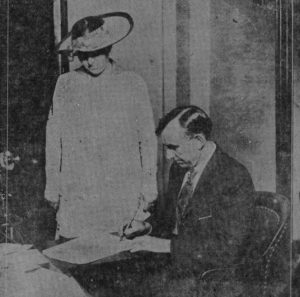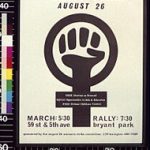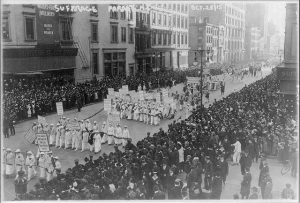The fight for women’s equality in the United States began at the Seneca Falls Convention in 1848. Advocates worked tirelessly circulating petitions, holding rallies and conventions, and marching in public parades. In this parade, 20,000 women marched in New York City, many of them wearing white as a symbol of purity. Supporters hoped women would clean up politics and government.
The text of the Nineteenth Amendment is brief: The right of citizens of the United States to vote shall not be denied or abridged by the United States or by any State on account of sex.
 The amendment went to the states for ratification in 1919. Supporters fanned out across the country in a state-by-state struggle. Tennessee completed the ratification process on August 18, 1920. On August 26, 1920 the Nineteenth Amendment became law. Women could vote, but not much changed.
The amendment went to the states for ratification in 1919. Supporters fanned out across the country in a state-by-state struggle. Tennessee completed the ratification process on August 18, 1920. On August 26, 1920 the Nineteenth Amendment became law. Women could vote, but not much changed.
FEMINISM: THE SECOND WAVE
In 1960 Betty Friedan published The Feminine Mystique, setting off what many call feminism’s second wave. This time women pushed for full equality in all areas of life. In 1966 leading feminists founded the National Organization for Women.
 Four years later, 50,000 women marched in the Women’s Strike for Peace and Equality, the first major women’s march since the suffragettes. The march was a symbolic gesture and work stoppage meant to draw attention to the unequal distribution of domestic labor, and to bring three goals into focus: free abortion on demand, equal opportunity in employment and education, and childcare centers open 24/7. Title IX, requiring equal educational opportunity, passed in 1972.
Four years later, 50,000 women marched in the Women’s Strike for Peace and Equality, the first major women’s march since the suffragettes. The march was a symbolic gesture and work stoppage meant to draw attention to the unequal distribution of domestic labor, and to bring three goals into focus: free abortion on demand, equal opportunity in employment and education, and childcare centers open 24/7. Title IX, requiring equal educational opportunity, passed in 1972.
Feminists also pressed for the Equal Rights Amendment to the Constitution. First promoted by Alice Paul and the National Women’s Party in 1923, Representative Bella Abzug introduced the bill in 1971. It passed both the House and Senate, and went to the states for ratification. [Ultimately, the amendment failed to achieve ratification by three-fourths of the states.]

In 1971 Representative Abzug also introduced a bill to recognize August 26 of each year as WOMEN’S EQUALITY DAY. The bill passed as a Joint Resolution of Congress.
WHEREAS, the women of the United States have been treated as second-class citizens and have not been entitled the full rights and privileges, public or private, legal or institutional, which are available to male citizens of the United States; and
WHEREAS, the women of the United States have united to assure that these rights and privileges are available to all citizens equally regardless of sex; and
WHEREAS, the women of the United States have designated August 26, the anniversary date of the certification of the Nineteenth Amendment, as symbol of the continued fight for equal rights: and
WHEREAS, the women of United States are to be commended and supported in their organizations and activities,
NOW, THEREFORE, BE IT RESOLVED, the Senate and House of Representatives of the United States of America in Congress assembled, that August 26th of each year is designated as Women’s Equality Day, and the President is authorized and requested to issue a proclamation annually in commemoration of that day in 1920, on which the women of America were first given the right to vote, and that day in 1970, on which a nationwide demonstration for women’s rights took place.
BELLA SAVITZKY ABZUG, also known as Battling Bella was a practical leader in the cause of women’s rights. She joined the New York Bar in 1945, not a time when professional women were welcome. Abzug participated in the civil rights and anti-war movements as well as the women’s movement. She served in the House of Representatives from 1971 to 1976. Her campaign slogan: “This woman’s place is in the House – the House of Representatives.” Bella’s hats became famous. When asked why she persisted in wearing them, Bella said that when she entered the work force, “Working women wore hats. It was the only way they would take you seriously.”
Famous quotes by Bella Abzug:
“The test for whether or not you can hold a job should not be the arrangement of your chromosomes.”
“I prefer the word ‘homemaker,’ because ‘housewife’ always implies that there may be a wife someplace else.”
“We are coming down from our pedestal and up from the laundry room.”
Sunday is Women’s Equality Day. Someday it will be Equality Day everyday.
?♀️?♀️??♀️
Illustrations:
Suffrage Parade in New York City, Oct. 23, 1915. Public Domain.
Tennessee Governor Albert H. Roberts certifies state ratification of 19th Amendment. Aug. 24, 1920. Public domain.
Poster for Women’s Strike, Aug. 26, 1970. Public Domain.
Bella Abzug. Public Domain.
Women’s Equality Day. National Women’s History Project.
Linda Charlton. “Women March Down Fifth in Equality Drive.” New York Times. Aug. 27, 1970.
Sari Rosenberg. “August 26, 1970.” My Lifetime. Aug. 26, 2017.

Sandra Wagner-Wright holds the doctoral degree in history and taught women’s and global history at the University of Hawai`i. Sandra travels for her research, most recently to Salem, Massachusetts, the setting of her new Salem Stories series. She also enjoys traveling for new experiences. Recent trips include Antarctica and a river cruise on the Rhine from Amsterdam to Basel.
Sandra particularly likes writing about strong women who make a difference. She lives in Hilo, Hawai`i with her family and writes a blog relating to history, travel, and the idiosyncrasies of life.



Wonderful way to start the day here in smoke shrouded Seattle. Thanks for this, an Aussie here in the USA for a few precious years, IWD in March has been the sole day of reflection/commemoration/celebration in the calendar. From now on August 26 will be another day of gratitude and resolve building. Wearing white, obviously :). Thanks for this and all your blog posts, so often a touchstone.
Toni — thank you so much for commenting. I’m disappointed Women’s Equality Day is so forgotten it doesn’t even appear on calendars. Seems like it’s more important than “Sweetest Day.” Glad you enjoy the blog. Be well.